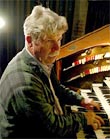|
|
This topic comprises 4 pages: 1 2 3 4
|
|
Author
|
Topic: When do you open the curtains?
|
Christopher Seo
Jedi Master Film Handler

Posts: 530
From: Los Angeles, CA
Registered: Jun 99
|
 posted 06-22-2004 05:17 PM
posted 06-22-2004 05:17 PM




I am fortunate to work at a theatre that has a working curtain (a traveler). However, I have gotten into a debate with the manager over the appropriate time to open the curtain. Since we rarely run any material before the feature, I usually open the curtain right when the studio logo comes on. Projectionists I have talked to gave me the impression that such timing was standard operating procedure. The roadshow booklets I have looked at tend to support this (found at The Widescreen Museum), except in cases where there was no studio logo.
However, the manager contends that projecting the logo on the curtain looks awkward, confuses the audience, and interferes with viewing the logo. I think that whether or not it looks awkward is a matter of personal taste, but in any case my goal is to be faithful to the historic industry practices. Thus, I want to find out what other projectionists' practices are (or in most cases, were) regarding the use of curtains. Do you wait for the logo to hit the curtain before opening it? Do you time the curtains so they are a third, or half of the way open when the logo hits? Do you open them entirely prior to the appearance of any image?
Also, have studios, producers, etc. ever made particular requests regarding the use of curtains?
| IP: Logged
|
|
Paul Mayer
Oh get out of it Melvin, before it pulls you under!

Posts: 3836
From: Albuquerque, NM
Registered: Feb 2000
|
 posted 06-22-2004 05:36 PM
posted 06-22-2004 05:36 PM





I usually did just as you're doing Chris--open up with whatever is at the head, and then open the traveller. That seems to be what I remember most operators doing too. The usual sequence I remember was:
- Fade the non-sync, select the non-starting projector, and set starting sound level.
- Roll motor and simultaneously dim the house.
- Two feet after the two-pop, changeover to operating machine picture and sound, then open the traveller.
Sometimes on roadshow releases, there would be instructions enclosed with the print detailing things like house light and curtain cue timings, and playback level and EQ for any overture tracks played with the curtain closed. One I specifically remember was the mid-70's 70mm re-release of Kubrick's 2001. We went to house lights at half at the beginning of the overture. There were additional cues for fading the house to black and opening the traveller, the idea being for the traveller to move while the house was completely dark. If the timing was perfect the stylized MGM logo would fade up just as the curtain cleared the full screen width (or height).
I know of other operators that liked to do it that way as their normal routine--have the curtain full open before the first frames hit the screen. In most cases it was whatever the operator or theatre manager thought best.
| IP: Logged
|
|
Scott Norwood
Film God

Posts: 8146
From: Boston, MA. USA (1774.21 miles northeast of Dallas)
Registered: Jun 99
|
 posted 06-22-2004 05:37 PM
posted 06-22-2004 05:37 PM





Interesting question. I usually hit the switch/button right when the douser opens, so that the screen becomes visible just as the first image fades in. At the end of the show, I start closing it so that the curtain stops moving just as the final image (credits, ratings band, etc.) fades out or cuts/scrolls to black. For repeated screenings of the same film, I add curtain cues (one-frame Clint Phare cues in the lower-right-hand corner) for when to start closing the curtain.
I should point out that I've mostly dealt with smaller theatres that have ~20-30-foot-wide screens. I'm not sure whether or not the timing changes in theatres with much larger screens, where the curtain takes longer to open or close completely.
Is this the "proper" procedure? I have no idea, but it seems to be common practice in most theatres that use curtains.
Edit: I use a modified version of Paul's method for dealing with house lights. In most theatres, I fade out the non-sync, dim house lights to half, then dim screen lights (one color at a time if multiple circuits), then start show/open curtain. House lights fade the rest of the way after trailers end.
Edit #2: I'm assuming manual operation here. If you have automation, there may be other factors which dictate when/how curtains/lights/music operate.
| IP: Logged
|
|
|
|
|
|
|
|
|
|
Paul G. Thompson
The Weenie Man

Posts: 4718
From: Mount Vernon WA USA
Registered: Nov 2000
|
 posted 06-22-2004 11:52 PM
posted 06-22-2004 11:52 PM




Christopher, it depends on the actual movie and what studio made it, and how long the logo lasts. Several theaters I have worked at required the Title Curtain - if it looked good. The theater owner let that up to the projectionist if the projectionist thought it looked good. Some theaters also required the curtains to close at the end of the trailers or cartoon and re-open as soon as the logo faded out. In my travels, the theater owner was also a professional projectionist. Usually, (but not always) did I follow his footsteps. It was MY SHOW....and the bosses always let me do what I thought was appropiate.
One effect I can relate - there was an old operator that ran a movie where the start was a "yellow glow" in the middle of the screen that got bigger and bigger. He held the curtain and kept the fader retarted just until the device behind the yellow glow blew its horn. It was a fast curtain, and when he parted the curtain, a big steam locomotive popped out and scared the audience. But, the audience loved it. ![[Smile]](smile.gif) ![[Smile]](smile.gif)
In today's movies, if one uses the title curtain, it might look like crap. This is where showmanship comes in. There is no set rule on how or what to do. If it looks nice and pleasing to the audience, go for it. If it does not, bag it.
There are other things I did in the later years of projection during the "Dirty Harry" movies. Remember the movie where the dog positioned it's rear end towards the screen and passed gas? Well, I just happened to be at the projection station waiting for that the nights I ran it, and I advaned the fader to 10 for that few seconds. I had the audience practically rolling in the aisles laughing their butts off. ![[Smile]](smile.gif)
In addition to that, I used to do hand douser changeovers from cartoons to movies. I nice smooth transition sure looks better than a "WHAM". At times, I did the superimposed change-overs as well.
Lots of operators have the curtain slam shut as soon as the credits end. Nothing wrong with that. The reason is in the next paragraph.
Many times the credits look good on a curtain that is closed, depending on how much the foot lights are set, what kind of curtain it is, etc. I could be wrong, but I think much of that practice has been discontinued because of the closing music, etc. Closing the curtain on that type of ending might be very annoying to the customers.
The rule of thumb I used was basically "eye appeal" and watching the customer's reaction. Rarely did I ever have a complaint lodged directly to me or to the management. As for today (if I had curtains) I would never close them on the credits.
| IP: Logged
|
|
|
|
William Hooper
Phenomenal Film Handler
Posts: 1879
From: Mobile, AL USA
Registered: Jun 99
|
 posted 06-23-2004 02:22 AM
posted 06-23-2004 02:22 AM





Basically, the traditional way has been to conform to the presentation ideal of never showing a blank screen at the beginning & end of the show. I think it has something to do with reinforcing the suspension of disbelief that you're seeing "a show". If there's no blank screen examined before a picture, the screen doesn't really register with the audience.
That translates to when the picture first hits the curtain, the curtain quickly goes out. If whatever's first has sound before picture, the house lights go down, that quiets the audience & they become anticipatory & receptive to the beginning of the 'production', sound plays with curtain closed, suspense is generated in *exactly* the way it was intended by the filmmaker in having sound alone before picture, then when the picture first hits the curtain, the curtain goes out as usual. Also, it not only de-emphasizes the hardware behind the illusion, but adds suspense & excitement with watching & interpreting all the action of appearance of picture then sudden motion of the curtain.
If the movie ends with the end of photography followed by a title roll, when the titles appear, the curtain is slowly brought in after the fact that 'here are the end credits' has registered. It's actually cool watching white on black titles on a colored, textured drape.
The end of the show is more difficult to strategize if there's a surprise scene after the credits or action continues under them. Safest is to just wait until black at the end (by then the credits have blown the whole suspension of disbelief by de-emphasizing the technology). I've seen some good shows where a projectionist is attentive to the content, has a sensitivity to how audience manipulation works & has been able to bring in the curtain if the action is "dead" in a short scene after the titles just in time to close on black.
Steve Kraus' approach of opening partially & hitting the logo would work for folks more accustomed to home video experience & seeing movies in theaters with material preceding the feature & no title curtain, resulting in an expectation of always fully seeing the logo. He's also in a special case as he's mentioned before, running a screening room where the people with a piece of the logo want to see it fully. Otherwise, it could look like the curtain is late. Like opening after the picture hits, I think some audience expectation due to a familiarity with seeing it a particular way factors into his audience.
| IP: Logged
|
|
Paul G. Thompson
The Weenie Man

Posts: 4718
From: Mount Vernon WA USA
Registered: Nov 2000
|
 posted 06-23-2004 02:49 AM
posted 06-23-2004 02:49 AM




William, you are, indeed, a showman and a true professional. Congratulations. I think the way you said it is superb. What you said was basically what I was hinting, but you did a much better job than I did on conveying that idea. ![[Smile]](smile.gif) ![[Smile]](smile.gif) ![[beer]](graemlins/beer.gif)
It would be a pleasure to watch YOUR SHOW!
It is truly a shame how showmanship and professionalism has taken a back seat to "Get 'em in like a herd of cows, collect their money, and roust them out as fast as possible before the credits are even over" type philosophy most major corporations and some mamma and papa organizations seemed to have acquired through the years. It would be a cold day in a hot place before I would ever sit and watch a movie in some Cinemaorgazmasmellyplex theater for that reason.
At the Strand Theater in Manitowoc, Wisconsin (even on the 9-cent days for the 12-year-old punks like me) the projectionist always used his footlights, faders, and curtains just like he would have done for a ritzie presentation for the local snobs. (And, there were plenty of them in Manitowoc.)
| IP: Logged
|
|
|
|
|
|
|
|
|
|
|
|
All times are Central (GMT -6:00)
|
This topic comprises 4 pages: 1 2 3 4
|
Powered by Infopop Corporation
UBB.classicTM
6.3.1.2
The Film-Tech Forums are designed for various members related to the cinema industry to express their opinions, viewpoints and testimonials on various products, services and events based upon speculation, personal knowledge and factual information through use, therefore all views represented here allow no liability upon the publishers of this web site and the owners of said views assume no liability for any ill will resulting from these postings. The posts made here are for educational as well as entertainment purposes and as such anyone viewing this portion of the website must accept these views as statements of the author of that opinion
and agrees to release the authors from any and all liability.
|

 Home
Home
 Products
Products
 Store
Store
 Forum
Forum
 Warehouse
Warehouse
 Contact Us
Contact Us




 Printer-friendly view of this topic
Printer-friendly view of this topic









![[Frown]](frown.gif) Wishing I had curtains at Lakeville.
Wishing I had curtains at Lakeville.

![[Smile]](smile.gif)

![[beer]](graemlins/beer.gif)




